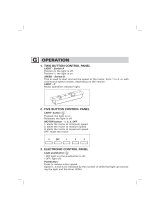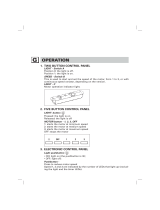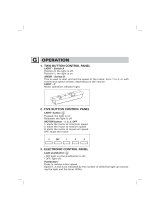
8
2. CHARCOAL FILTERS
These trap the odours present in the stream of air that passes through
them. The air is purified by passing a number of times through the filters
and being recirculated into the kitchen. The charcoal filters cannot be
cleaned, and should be replaced on average every 3-4 months (according
to use). To replace the charcoal filters, see the instructions in point H2.
3. CLEANING THE OUTSIDE OF THE APPLIANCE
The ouside of the range hhod should be cleaned using a damp cloth and
neutral liquid detergent or denatured alcohol.
In case of fingerprint-less finish (fasteel) clean only with water and neutral
soap using clean with a soft cloth, rinse and wipe dry thoroughly. Do not use
products that contain abrasive substances, rough cloths or cloths specifically
designed for cleaning steel. Using abrasive substances or rough cloths will
inevitably damage the finish of steel.
The steel surface will be irrevocably damaged if the instructions above are
not complied with.
Keep these instructions together with the instructions for use of your hood.
The manufacturer accepts no liability for any damage caused by non-compli-
ance with the instructions above.
4. CLEANING THE INSIDE OF THE APPLIANCE
The electrical parts or parts of the motor assembly inside the range hood
must not be cleaned using liquids or solvents.
Do not use abrasive products.
All the above operations must be performed after having disconnected the
appliance from the mains power supply.
SAFETY WARNINGS
M
The electrical system features an earth connection in compliance with in-
ternational safety standards; furthermore, it is compliant with the European
standard for electromagnetic compatibility.
Do not connect the appliance to flues (from boilers, fireplaces, etc.). Make
sure the mains voltage corresponds to the values on the rating plate located
inside the range hood. The minimum safety distance between the cooktop
and the range hood must be at least 65 cm.
Never cook on “open” flames under the range hood.
Check deep-fryers during use: superheated oil may be flammable.
- Ensure there is adequate ventilation of the room when the rangehood is
used at the same time as appliances burning gas or other fuels.
- Do not flambe under the rangehood
- The exhaust air must not be discharged into a flue which is used for exhaust-
ing fumes from appliances burning gas or other fuels.
- Ensure that all regulations concerning the discharge of exhaust air have
been fulfilled before you use the appliance.
Before performing any cleaning or maintenance operations, disconnect the
appliance by unplugging it or using the main switch. The manufacturer dis-
claims all liability for any damage that may be directly or indirectly caused
to people, things and animals due to the failure to follow all the instructions
provided in this booklet and above all the warnings relating to the installa-
tion, operation and maintenance of the appliance.












